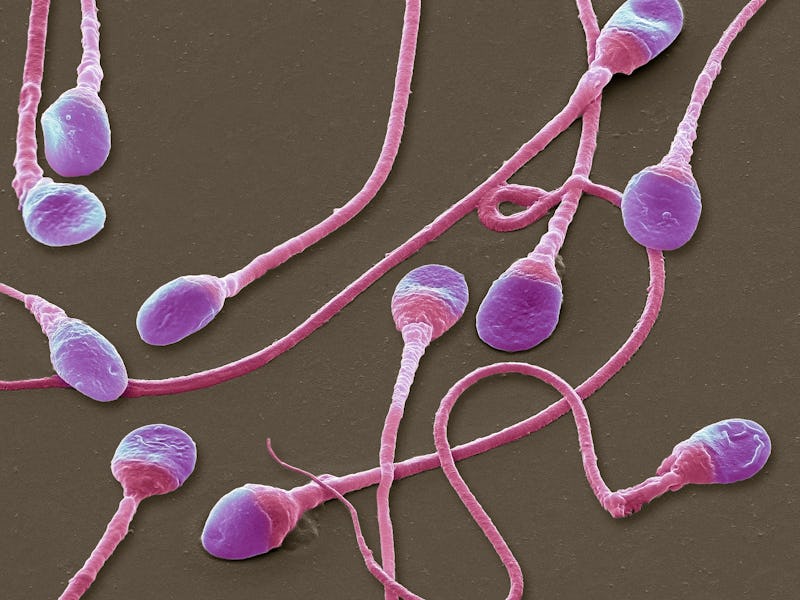Scientists say all men have 'selfish sperm'
Sperm compete in a "shocking" pre-birth competition, according to a new study.

Competition is everywhere we look in society—people trying to get better jobs, advantages for their children, or even risking breaking the law to get a coronavirus vaccine. Competition is also rife at the biological level — evolution, after all, is essentially a competitive sport, one that humans have so far been pretty good at winning.
Humans also compete with each other — like all animals, we are biologically driven to try and pass our genetic material on to the next generation, and for the males of the species, that means succeeding at mating and producing offspring, aka having kids. For men, this means passing their DNA down via sperm cells.
Scientists thought they had a pretty good handle on how this worked. But according to a new study published January 14 in Science, sperm are actually far more selfish than previously thought. The study was funded by the Massachusettes-based Ohana Biosciences.
Essentially, the new findings suggest natural selection starts on the sperm vs sperm level, long before conception. In other words: Men aren't just in competition with one another on the evolutionary level — individual sperm are, too. This has profound implications for how we understand genetic inheritance, and how genes influence behavior, development, and even disease.
What's new — The study challenges the long-held scientific consensus about how genetic traits are passed down.
Study co-author Robin Friedman is the Senior Director of Computational Biology at Dragonfly Therapeutics and performed all the research while a full-time-employee of Ohana, where he remains a consultant. He tells Inverse that “since the time of Mendel, our understanding of genetics has relied on the fact that alleles — i.e. the two copies of each gene I have, one from my father and one from my mother — are randomly distributed with a 50/50 chance to each of my offspring.”
To put that in context, Friedman is referencing Gregor Mendel, the Austrian monk widely recognized as the founder of modern genetics. Mendel’s work on peas took place in the 1860s and his first law, also known as the law of segregation, promotes the random distribution to which Friedman is referring.
The new study has roots in the works of Austrian monk Gregor Mendel, the father of modern genetics.
For alleles to be randomly distributed with a 50 percent chance of being passed onto offspring, it would require sperm to be “functionally equivalent,” Friedman says. That means at a physical level, all sperm would have to be equally adept at swimming through cervical mucus, equally proficient at fertilization... you get the idea.
“That is still mostly true,” Friedman says. But it turns out not only are there exceptions to the rule, these outliers are “far more frequent than previously thought.”
Friedman’s team discovered a mechanism through which “the expression of genes in sperm can be linked to their genotype — i.e. the allele they are carrying — for many thousands of genes. This can lead to functional differences between sperm more often than previously thought, allowing competition between sperm which violates Mendel's first law.”
How they did it — By comparing the expression ratio of alleles in more than 12,000 genes, Friedman and the study’s other authors found some sperm don’t share their gene variants. In fact, there are some genes the expression patterns for which are linked to their genotype in sperm. The team labeled these "geoinformative markers," or GIMS.
Why it matters — A child born with GIMS could have functionally different traits than a child born without — regardless of whether or not they had the same set of parents.
“Sperm that have functional differences due to GIMs could lead to a ‘selfish gene’ effect,” Friedman says. In this scenario, Friedman explains "alleles spread through a population quickly because they help sperm compete, but not because they help the entire organism survive overall."
The research has the potential to change our understanding of human genetic inheritance, introducing the idea that “non-random inheritance of alleles is far more common” than scientists have previously thought, although the difference might be subtle. Instead of a 50-50 random distribution, it could be slightly tilted towards 45-55 towards a sperm with a geoinformative marker. The effect could be hard to detect on an individual level, with a large number of offspring needed to recognize the shift towards the selfish gene.
What's next — The work has an important implication — namely that there could even be sperm-level natural selection, Friedman says. But the results don't bear this out. More work will be needed to confirm how natural selection works on the sperm level.
Another open question is the degree to which Mendel's first law doesn't hold true when it comes to human evolution and natural selection at large.
“There had been a small number of exceptions to Mendel's first law reported before, so we expected to find a small handful of new ones,” Friedman says. But the team was “frankly shocked and pleasantly surprised to see thousands” of geoinformative markers.
The competition really does start early, it seems.
Abstract: Sperm are haploid but must be functionally equivalent to distribute alleles equally among progeny. Accordingly, gene products are shared through spermatid cytoplasmic bridges which eras phenotypic differences between individual haploid sperm. Here, we show that a large class of mammalian genes are not completely shared across these bridges. We term these genes "geoninformative markers" (GIMS) and show that a subset can act as selfish genetic elements that spread alleles unevenly through murine, bovine, and human populations. We identify evolutionary pressure to avoid conflict between sperm and somatic function as GIMS are enriched for testis-specific gene expression, paralogs, and isoforms. Therefore, GIMS and sperm-level natural selection may help explain why testis gene expression patterns are an outlier relative to all other tissues.
This article was originally published on